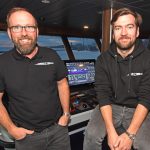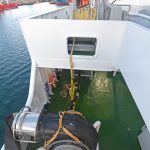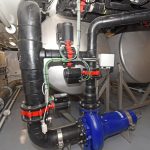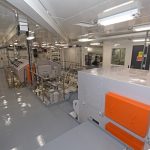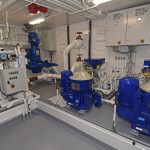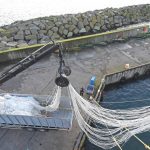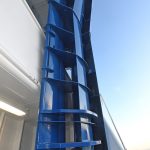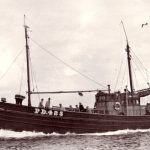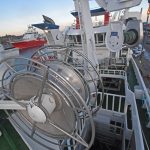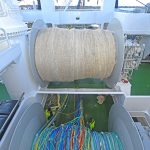New Peterhead pelagic vessel quickly starts to prove her capabilities on west-of-4° mackerel
The new Lunar Bow arrived at Peterhead from Denmark at the same time as mackerel started to cross the 4° line and swim strongly into the southwest past the Butt of Lewis and Barra Head during a period of heavy North Atlantic weather, which provided an immediate opportunity for the skippers and crew to establish the fishing and sea-keeping credentials of the new vessel, reports David Linkie

Lunar Bow arriving at Peterhead for the first time.
After spending a day alongside at Peterhead to take aboard the balance of her midwater trawl gear, Lunar Bow returned within 48 hours to land her maiden shot of mackerel, taken in two short tows west of Orkney. A few days later, during which time Lunar Bow steamed across the top of Scotland in a storm-force westerly gale and dodged down the east side of Lewis for a few hours before fishing west of the Butt, the vessel landed her second shot into Peterhead. A repeat situation occurred last week, when Lunar Bow encountered Storm Ciara before fishing southwest of Barra Head.
Father and son skippers Alex and AJ Buchan and crew were quietly pleased with all aspects of Lunar Bow’s performance in the first two weeks of operation, especially at a time when all crews were under pressure to take their 40% allocation of mackerel west of the 4° line, with the fish moving some 30 miles a day.
That Lunar Bow started fishing in January, the scheduled completion date that Karstensens Shipyard gave skipper AJ Buchan when the build contract was signed at the DanFish exhibition in October 2017, is testament to the high level of efficiency for which Karstensens is renowned.
Lunar Bow is the first new vessel to be built by the company’s newly established subsidiary Karstensens Shipyard Poland. Fabricating hulls and superstructures in-house in one of two extensive fabrication halls at Gdynia, rather than subcontracting hull construction to other yards, gives Karstensens full control of the build schedule – the benefits of which are clearly showcased by Lunar Bow. After being launched at Gdynia, Lunar Bow arrived in Skagen in August 2019 for completion.
The new build continues the well-established working relationship between the Lunar Fishing Company Ltd and Karstensens Shipyard, which goes back some 30 years to when a previous Lunar Bow was lengthened at Skagen.
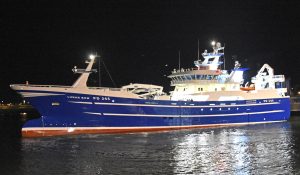
Lunar Bow leaving Peterhead for her first trip.
Since then, Karstensens has delivered the 28m whitefish pair-seiners Harvester and Ocean Harvest in 2008, followed by the 78.75m pelagic vessel Kings Cross PD 365 in October 2016 and her sistership Pathway PD 165 six months later.
While these diesel/electric-drive dual-purpose purse-seiners/midwater trawlers provided a starting point when the owners and yard began discussions, Lunar Bow features a totally new hull design, in which increasing buoyancy and freeboard were key considerations, together with achieving optimum working efficiency, safety and comfort for the crew, catch handling/storage facilities and propulsion efficiency/fuel consumption.
In numerical terms, the LOA was increased by 1.45m and the beam by 0.5m.
Visually, the main differences are that amidships the hull sides are continued up to boat deck level, thereby enclosing the RSW tank tops at shelterdeck level, and the presence of a long forecastle deck/whaleback, which in addition to increasing freeboard at the stem gives Lunar Bow a more traditional profile. Aft, the boat deck was extended to the trawl gantry and recessed inboard around the fish pump station to port.
Below the waterline, the underwater hull sections forward were filled out.
Two hours before Lunar Bow left Peterhead to fish her first trip, skipper AJ Buchan said: “We are more than happy with the end result, to which a lot of people have contributed. Kent Damgaard and the rest of the Karstensens team were extremely helpful and good to work with.

The messdeck…
“Designing any boat of this nature is a complex task. Fortunately, from my perspective, having been directly involved in building and skippering five other new pelagic vessels, my father was able to draw on his extensive knowledge. This proved invaluable, particularly in terms of fine detail, which often makes a considerable difference.
“Taking on a new boat as a relatively young skipper is an exciting but equally challenging experience, but one that I am looking forward to, secure in the knowledge that the crew have a vast amount of experience to support me with.”
General arrangement
Featuring two continuous decks, main and shelter, and built to DNV-GL +1A Fishing Vessel EO TMON Ice-C, Lunar Bow’s round bilge hull has an LOA of 80.2m, length between PP of 70.2m, beam of 16m, depth to shelterdeck of 9.2m and a scantling draught of 8m.
The long forecastle, and the upper boat deck aft on the full-length boat deck, give the vessel a streamlined profile that is further enhanced by the stylish aluminium wheelhouse, on which a double radar gantry is mounted.
Having previously been fully satisfied with the benefits associated with internal corridors at main deck level either side of the RSW tanks, together with separate vacuum discharge and RSW machinery rooms, the owners opted for similar arrangements on Lunar Bow.

… and adjoining dayroom…
As a result, the hull below the main deck is subdivided into forepeak, bow thruster/sonar room, RSW pump and manifold room, insulated RSW tank section, engineroom, and aft peak with fuel and lube oil tanks.
At main deck level, the arrangements from forward are forepeak, RSW machinery room, forward RSW trunk section, central vacuum landing room, and the two aftmost tiers of RSW tanks. Aft of these working arrangements, a combination of eight single and twin-berth ensuite cabins lie to starboard of the vessel’s centreline. The engine control room is positioned on the port side, forward of a well-equipped workshop and the hydraulic pump room. A fitness room is also arranged aft on the starboard side.
A further four single-berth cabins and the hospital cabin are located in the full-width superstructure at shelterdeck level, together with protective clothing storage, a changing room, a coffee bar, a large trawl workshop and a fishing sensor charging room.
Cooks James Campbell and Gordon Pirie’s customarily equipped stainless steel galley is positioned to starboard in the accommodation structure at boat deck level, together with separate walk-in dry-provision and fridge/freezer rooms, aft of the messdeck, where a large oval-shaped table and heated food self-serve arrangements are key features.
An open-plan spacious day lounge is arranged to port, forward of a second smaller glass-enclosed cinema room.
Four further ensuite skipper’s cabins, together with a walk-in room housing the array of computers for the vessel’s electronic equipment, are located on the next deck up under the wheelhouse.
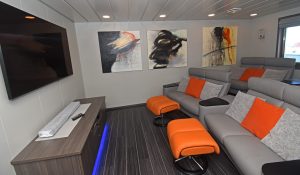
… and cinema room to port.
Lunar Bow features an exceptionally high level of internal finish throughout the accommodation areas, which really has to be seen to be fully appreciated. A key feature is extensive use of solid walnut, beautifully crafted and finished in-house by Karstensens. Light-coloured planked flooring underpins a modern look, which is further enhanced by a combination of modern artwork and atmospheric photographs taken on previous Lunar Bows.
Midwater trawling
Karmøy Winch AS supplied the extensive package of purse and trawl deck equipment installed on Lunar Bow, based on the owners’ previous successful first-hand experience.
The 90t core-pull split trawl winches positioned abaft the accommodation casing to port and starboard on the boat deck are operated through a Karm autotrawl system.
Spooled with 2,000m lengths of 38mm-diameter Bridon Starfish wire supplied by Jackson Trawls, the winches give parallel elevated leads to the inboard hanging blocks suspended within the underside of the stern gantry, to which companionways give ready access. This arrangement ensures that the crew have clear and immediate access to the midwater gear from two levels when clipping on/off helper pennants/backstrops etc.

Midwater trawling equipment is arranged over three decks aft of the superstructure casing, as viewed from atop the stern gantry.
Midwater trawling is just one of the functions performed by the Karm Datatrawl system, which also delivers a full hydraulic management programme controlling the array of six 158kW, three 110kW and two 88kW electro/hydraulic power packs that are situated in a dedicated room aft on the port side of the main deck, in close proximity to where all of the trawl machinery is located. Selected operating modes matched to working practices now being established on Lunar Bow are programmed into the Karm Datatrawl system. This ensures that the optimum combinations of hydraulic pumps are always available, allowing the operator to concentrate fully on activities on deck – of which the commanding trawl console in the wheelhouse provides an excellent view, assisted by a good clearance between the trawl doors.
Midwater trawls are worked from two 110t net drums positioned centrally on the shelter and boat decks in waterfall style, above a single set of toe-end weight tracks.
A 71t lifeline winch for handling the bag is located on the starboard side of the upper boat deck, directly above the trawl winch. A 51t tailend winch, used for pulling the bag to the stern before the sock is taken up and attached to the aft fish pump, is positioned in a similar location to port, in line with a dedicated sheave mounted within the mid-height trawl gantry.
Two outhaul winches are mounted on the underside of the stern gantry for use when shooting away the bag and other duties on the trawl deck. When fishing in poor heavy weather, the central opening through which midwater trawls are worked can be sealed off by raising a hydraulically operated gate, positioned aft of the four customary guiding-on pins.
Purse-seining
The purse net bin is situated aft on the starboard side and is recessed into the shelterdeck. In keeping with modern practice, the net is shot away through a rectangular opening between the level of the main boat deck and the raised second boat deck that extends aft from the front of the accommodation casing. The large radiused outer top edge of the net bin is constructed from stainless steel to minimise rubbing.
Two 40t purse winches, together with a 20t end wire winch, are mounted forward of the RSW tank tops on the port side of the shelterdeck. One of the purse winches is aligned to lead the 34mm-diameter Dyform wire aft to a hanging block and the pursing needle, while the second unit has a direct lead across the beam to a second block on the forward gallows.

The starboard 90t split trawl winch.
Supplied by Mørenot AS of Norway, Lunar Bow’s 430 fathom by 117 fathom purse net will be hauled by a Karm Tristar Giant net hauler. When the purse has passed through the triple rollers, the net is pulled through a large-diameter stainless steel chute by an intermediate roller, from where it is hauled further aft by a Karmøy net stacker and a Triplex float stacker, before being stowed in the bin ready for the next purse.
An extensive area for mending the purse seine is arranged forward of the net bin at shelterdeck level.
Karmøy also supplied four remote-controlled deck cranes that provide invaluable assistance when handling the midwater nets and pumping fish. In addition to the folding netstacker unit that includes a 4t roller and a 5t winch on a 13m reach positioned between the purse bin and the trawl deck, a 5t/10m knuckle-arm pump for handling the aft fish pump is mounted on the trawl gantry directly over the port support leg for maximum strength.
A 4t/18m gooseneck-style crane covers general handling duties amidships, where a fourth Karmøy crane, rated 4t/13m, is also located to handle the purse net fish pump.
Fish pumping
Trawled catches of blue whiting, herring and mackerel will be taken aboard aft on the port side of Lunar Bow using one of two 24in fish pumps manufactured by SeaQuest Systems, thereby continuing the company’s well-established association with the Lunar Fishing Company.

A pump-through hydraulic hose reel connected to the overhead stainless steel delivery pipe is mounted on the shelterdeck.
While the skipper and crew have extensive experience of pumping over the stern, the boat is the first Lunar Bow to feature this arrangement.
One of the main advantages of pumping at the stern is that by eliminating the need to take the bag forward when the vessel lies broadside on to the weather, hauling the bag becomes a continual process, with the added bonus of the vessel not having to change course. While using the net drum to dry up the brailler, the 57t tail-end winch mounted to port on the upper boat deck is used to haul the bag to the quarter, before the sock is attached to the pump located on the main boat deck just forward on the trawl gantry.
The hydraulic pipe reel is situated alongside the fish pump on the boat deck, while the reel from which the fish hose is worked is directly below on the shelterdeck. The fish hose permanently connected to the pump lies in a deep vertical slot in the port side of the transom, allowing the hose to run clear of the stern as the pump is lowered into the water by the dedicated overhead crane.
A short clear Perspex section of pipe (the looking glass) enables the crewman controlling pumping operations to constantly monitor the flow of fish. The large-diameter stainless steel pipe extends some 35m forward on the port side on the underside of the boat deck, before turning inboard towards the fish/seawater separator system mounted within the boat deck amidships.
Further evidence of the high level of build quality found throughout Lunar Bow is provided by the fact that the pipe is fully enclosed along the sidedeck. This attention to detail is further highlighted by the extensive double-skin plating on the sides of the hull and the underside of the decks, which by providing a flush surface rather than numerous frames will make the boat considerably easier to keep clean in years to come.
When purse-seining, usually at the start of the autumn fishery in the North Sea, mackerel will be pumped aboard slightly forward of amidships on the starboard side, with the associated equipment located on the boat deck.
Catch storage

A SeaQuest 24in pump is positioned on the port quarter of the boat deck, aft of a tail-end winch on the upper boat deck, which is continued to the transom while being recessed inboard above the pump.
When pumping, the flow of pelagic fish from the separator into the 12 RSW tanks is remotely controlled from a dedicated pump room located within the centre deckhouse, which also contains an adjacent sampling room.
On entering the water separator, fish are directed upwards before sliding either forward or aft into transverse troughs, from where they are directed to the allocated RSW tank by remotely operated vertical gate valves.
Twelve stainless steel pipes are used to deliver fish directly into the selected RSW tank. One advantage of this modern system is that it leaves the tank hatches clear for the engineer to easily check the level of fish visually, without the need to move the delivery chute aside.
Deep coamings positioned in close proximity to the two groupings of RSW tank tops retain seawater and any floating waste overspills, rather than them flowing across the deck. Excess water is continually drained through recessed wells and one-way flaps for return to the sea on either side of the vessel
Arranged in four banks of three, the 12 RSW tanks on Lunar Bow have an internal volume of 2,572m³. This ensures that optimum levels of catch quality will be delivered each trip, with the vessel’s skippers and engineers having maximum flexibility in selecting the ratio of fish to seawater at all times.
With buyers worldwide requiring ever-higher standards of catch quality, the owners have put a strong emphasis on landing a top-quality product by being able to reduce the temperature of pelagic fish entering the RSW tanks to an optimum storage temperature of between 0°C and 1°C as quickly as possible. Two ammonia-based refrigeration plants supplied by Johnson Controls deliver 2.3mKcal/hr of cooling capacity, often enabling pelagic catches to be brought down to the desired level in less than two hours, depending on the quantity of fish pumped aboard and the number of RSW tanks brought into use. Featuring remotely operated valves, Lunar Bow’s RSW system is served by two 950m³/hr circulation pumps and two 300m³/hr condenser pumps.
Pelagic catches are discharged to processing factories ashore by a twin MMC 4,200-litre vacuum pumping system. Using four 66kW vacuum power packs, the system has a discharging capacity of up to 2 x 150t per hour.
The distribution of pelagic fish into the RSW tanks, through tank sounding and pump and valve control when pumping, is just one of the functions performed by a monitoring system developed and delivered by Johnson Controls.
In addition, a similar system was supplied by Norwegian company Marine Control Systems. This easy-to-use system monitors all aspects of onboard management, including the performance of the main and auxiliary engines, electrical supply and distribution, alarms, fuel/oil capacities and transfer, ballasting and electrical loading.
Engineroom
Lunar Bow features the new-generation Wärtsilä 31 medium-speed engine recognised by Guinness World Records as being the most efficient four-stroke diesel engine.

Two Caterpillar C32 gensets deliver 940kWe each.
The second-generation series of common-rail-driven Wärtsilä 31 engines set a new benchmark in efficiency and overall emissions performance. Diesel fuel consumption can be as low as 165g/kWh, putting it significantly ahead of any other four-stroke diesel engine currently on the market.
Its exceptional fuel efficiency is made possible through the use of new technologies, such as two-stage turbocharging, a high-pressure fuel injection system and adjustable valve actuation, in combination with the next-generation engine control system.
The 31 range is the result of engineers at Wärtsilä starting from a completely blank slate to develop a new engine family that would be considerably more efficient than anything that had come before, rather than improving an existing design.
Designing a new engine entirely from the bottom up gave the unique opportunity to examine all of the various factors that contribute to engine efficiency, making improvements in each to achieve the greatest possible gain. Combustion quality, engine parameters, heat and flow loss prevention, and internal friction were among the issues exhaustively explored and addressed.
The most critical advance in the Wärtsilä 31 range is an engine structure designed expressly to accommodate two-stage turbocharging. While the considerable boost in efficiency associated with two-stage turbocharging was well-known, no existing engines were capable of taking full advantage of the effect. They simply could not stand up to the loading and strain that results from the step change in firing pressure. To overcome this, the engineers gave the entire Wärtsilä 31 engine structure a very robust design.
A fundamental advantage of the Wärtsilä 31 is its flexibility. The engine can be continuously operated at 10% load, and can reach full load within as little as two minutes of the start command.

Two Johnson Controls ammonia-based refrigeration plants delivering 1,345kW each are located forward at main deck level.
A major contributor to the engine’s increased flexibility is its completely redesigned valve actuation method. The new design replaced the mechanical, rocker-arm-driven valve mechanism of previous models with a hydraulic system. This feature allows very smooth and precise control of valve timing, to ensure that the fuel-air ratio in the cylinder is optimised at all times. In this way, the engine can take maximum advantage of the boost provided by two-stage turbocharging, especially on partial loads.
Optimised engine parameters and adjustable inlet valve timing, combined with electronic ignition timing, result in fewer unburned hydrocarbons, and therefore vastly improved efficiency and lower emissions, irrespective of the load. An added bonus of the hydraulic valve actuation concept is that there is no need for valve clearance adjustment.
Wärtsilä 31 engines also feature a next-generation fully integrated automation system that regulates valve timing, gas admission, ignition, coolant temperature and various aspects of the turbocharging. All sensors are connected directly to the control ports, without going through connectors or junction boxes – changes that further enhance reliability.
The Tier III-compliant 10V31 engine is part of Lunar Bow’s fully integrated Wärtsilä propulsion system, which includes a Wärtsilä SCV 100/2PDC68 two-speed gearbox with reduction ratios of 5.19:1 and 6.25:1 and a 4,200mm-diameter CP propeller system housed in a high-performance fixed nozzle. Adjustments made from the wheelhouse in line with prevailing conditions effectively give minimum and maximum propeller speeds of around 100 and 150rpm. This combination of centreline machinery enabled Lunar Bow to record a top speed of 17.5 knots on trials.
A PTO on the gearbox drives a Marelli shaft generator delivering 4,250kVA @ 1,200rpm.
Auxiliary electrical power on Lunar Bow is provided by three Caterpillar gensets delivering a combined output of 2,100kWe.
A Caterpillar C32 (940kWe @ 1,800rpm) and a C7.1 harbour set (200kWe @ 1,800rpm) are housed in a soundproofed compartment on the port side in the engineroom. A second C32 genset is located at shelterdeck level in the forecastle.
When Lunar Bow is hauling and shooting fishing gear, the gearbox PTO will be clutched in, enabling electric power for the electro-hydraulic motors to be supplied from the shaft alternator. This arrangement reflects the fact that when full power is required for the deck machinery, there will normally not be the same demand for power on the main engine, allowing it to meet the requirements of both the propulsion and the hydraulic systems.
During normal towing, the shaft alternator can be disengaged from the switchboard, when electrical power is supplied by either of the gensets, through the main switchboard and controlled by the vessel’s DEIF Delomatic 4 power management system. A bus-bar breaker is also fitted in the main switchboard, allowing the aft thruster to be fed off the shaft alternator, while the forward thruster and domestic load are supplied by the gensets.
The vessel’s electrical power system is fitted for sliding frequency (50-60Hz), by means of frequency converters for 400/440V and a rotating frequency converter for 230V, allowing the main engine and propeller rpm to be reduced by 17%.

Port quarter view of Lunar Bow.
Lunar Bow is the latest Scottish midwater vessel to feature a diesel/electric propulsion system. A dedicated clutch fitted between the main engine and gearbox enables the shaft generator to function as an electric motor to drive a separate Marelli pony motor, being fed off the auxiliary engines. Up to 1,500kW can be used for this diesel-electrical propulsion drive, which on engine trials gave Lunar Bow a highly creditable speed of 12 knots.
The full electrical installation on Lunar Bow was carried out by Karstensens Shipyard’s subsidiary company KS Elektro A/S.
Two Brunvoll electrically driven tunnel thrusters (1,300kW), in which skewed bladed propellers combine optimal thrust with low noise, assist vessel handling in confined areas and when keeping station to fishing gear.
The double bottom tanks can carry 586,000 litres of fuel, while the vessel’s freshwater capacity is 105,000 litres. One hundred and twenty-eight tonnes of seawater can be carried in the forepeak, with 55t held in a passive anti-roll tank positioned under the forecastle deck along with the anchor winch.
Engineers Michael Willox, Alan Lawson, Phil Mclean, Alan Dennison and Liam Taylor monitor the performance of all the vessel’s propulsion and generating machinery, catch storage systems and the comprehensive alarm systems from a separate soundproofed control room and office, sharing 24-hour watch duties. Situated on the port side of the main deck, the control room also houses the main electrical switchboards and the computer monitors for the MCS vessel management system.
Scanmar ScanBas 365 net-monitoring and catch control

Scanmar UK general manager Liam Youngson fine-tunes the Scanmar ScanBas 365 net- and catch-monitoring system.
Lunar Bow uses a ScanBas 365 catch-/net-monitoring system supplied and installed by Scanmar UK Ltd of Peterhead.
A combination of the new wide digital receiver (WDR-42) and the latest 365 software allows the sensors to be configured from the multi-display screens in the wheelhouse.
A Trawl Eye system, positioned both on the headrope and in the tunnel section, provides continually updated information on the location and movement of fish towards the brailler, on which six SS4 super-catch and angle sensors are mounted along the full length, for fast updates on fish movement. As fish move down the length of the bag, Scanmar’s super-catch angle sensors present a visual of the bag as the twist reduces, confirming that the fish are ‘caught’.
One combined SS4 depth/height sensor is also mounted to monitor the depth of the codend during a tow, but also to monitor the height of the bag in relation to the seabed when heaving up, avoiding snagging.
Scanmar SS4 distance/depth sensors on both trawl doors, partnered with door angle sensors, provide information on both trawl door depths in relation to the surface.
Door angle and distance measurements are monitored during alterations to port or starboard, so that the trawl opening is kept optimal while towing.
Sensor signal reception while trawling is collected from four H4B30X50 single-beam hydrophones, mounted on both port and starboard blister housings.
Four QBC-X1 charging units are mounted on the charging wall in a readily accessible store forward of the trawl deck. The new Scanmar Sensor Configuration Unit (SCU) is also mounted on the charging wall, so that all sensors can be moved from their dedicated mounting position within the system, or simply reconfigured for different applications on the trawl.
Jackson Trawls provides extensive fishing gear package

Jackson Trawls delivers a new 1,300m dual-purpose herring/mackerel midwater net…
Jackson Trawls of Peterhead continued its long association with Lunar Fishing by supplying an extensive package of midwater nets, sweeps, wires and fishing chandlery to Lunar Bow.
While Lunar Bow was berthed at Peterhead for 24 hours before leaving for her first trip, the crew took aboard a new 1,300m dual-purpose mackerel/herring trawl.
Based on a well-proven design, this trawl is built with Jacinto twine in the mouth of the net and has an eight-panel tunnel section. Consisting of polyethylene-covered nylon, Jacinto twine is reported to work well, shooting cleanly and quickly off the net drums.
Featuring colour-coded wings, 25.6m mesh in the top and side panels and 12.8m mesh in the lower panel, the net is rigged on Dyneema frame ropes.

… to Lunar Bow.
Jackson Trawls also supplied two 70m braillers to Lunar Bow. Incorporating eight panels along their full length, the heavily constructed bags are made to a new and slightly wider design giving greater internal volume geared to pumping pelagic fish at the stern.
Jackson’s is scheduled to deliver a 1,200m herring trawl to Lunar Bow in time for the start of the North Sea summer herring fishing. To be built from Jacinto twine and three-strand twisted polyrene nylon, this net, which will have 12.8m and 6.4m meshes around the mouth, will also incorporate an eight-panel tunnel and Dyneema frame ropes.
During the blue whiting fishery west of Ireland in March and April, when fishing out of Killybegs, Lunar Bow will tow a custom-designed 2,048m blue whiting trawl which, again utilising Jacinto twine in the wings, performed well on the previous boat together with blue whiting bags from Egersund Trål.
Jackson Trawls also supplied two 2,000m lengths of 38mm-diameter Bridon Starfish trawl wire and 1,300m 32mm-diameter Dyform purse wire to Lunar Bow. A full package of 100m Lankoforce-covered Dyneema sweeps, made up in 50m and 100m lengths to give maximum flexibility when rigging the gear, also came from Jackson Trawls, along with a 500m Dynex Dux lifeline.
Lunar Bow is using a set of Thyborøn Type 22 BlueStream 13m² trawl doors to spread the midwater trawls.
Swan Net-Gundry Self-Spreading trawl
Killybegs netmaker Swan Net-Gundry supplied the midwater trawl used for Lunar Bow’s fishing trials from Skagen, and now being used during the mackerel fishery.
The 1,280m net is one of SNG’s very popular Helix Self-Spreading trawls, which skipper AJ Buchan fished successfully on the previous Lunar Bow.
This trawl is built with 25.6m full meshes in the top and side panels, which are also colour-coded for easy identification. The bottom panel has a reinforced section with 6.4m mesh. The trawl tunnel consists of eight panels – this option has become the new standard with many SNG trawls. The added benefits, compared to the traditional four-panel version, are better water flow, more stability and added strength.
The Helix Self-Spreading trawl is mounted on the very popular Kraftex frame ropes and finished with a dropper system in the best galvanised tested chain.
Furuno big bridge system gives fully integrated control
Three companies in NE Scotland supplied the extensive array of electronic navigation and fishing equipment installed on Lunar Bow. One of these companies was Woodsons, thereby maintaining Lunar Fishing’s longstanding relationship with Steven Wood.
Lunar Bow’s wheelhouse features a Furuno big bridge system, in which five 55in 4K Hatteland floor-mounted screens and 18 26in Hatteland fixed screens display all the navigation, fish-finding and net-monitoring data, in different configurations depending on the vessel’s prevailing mode of operation.

Five 55in Hatteland display screens are the focal point of the Furuno big bridge system.
Designed by Bruce Hardy, Furuno UK’s sales director, the system is driven by an advanced video wall controller integrated into a touchscreen command and control system. The skipper can select steaming, searching, fishing and harbour modes, and the bridge will automatically reconfigure to the required layout.
Three 24in touchscreen command centres are located on the port and starboard consoles, and aft at the winch controls. From here, the skipper can use a single trackball or touchscreen to control all the navigation and fishing equipment on the vessel. The touchscreen has soft-touch controllers that copy the radar, ECDIS and sonar keyboards, allowing them to be mounted out of sight, to keep the bridge clean and uncluttered.
Housed in a dedicated instrument room directly below the wheelhouse, two racks contain 10 separate computers, while eight bespoke radar, sounder and ECDIS processors are networked into both the Furuno control system and the Furuno video wall display system. Backed by three independent redundancy power supplies, the video wall controller takes in all the images from the equipment, and allows everything to be displayed anywhere on the bridge.
During searching, the 55in displays can be used to their full advantage, displaying full-screen high-resolution (4K) sonar images. This layout can be changed with one touch to show split-screen CCTV with radar chart overlay and conning information, for steaming or entering harbour.

General view of the wheelhouse.
That some 90km of electrical cabling is installed on Lunar Bow highlights the advanced level of technology now commonplace on this class of vessel.
Located two levels above the boat deck, the wheelhouse provides a commanding 360° view through the full-height windows.
The Furuno big bridge system is located in front of two NorSap 2000S skipper’s chairs, positioned between wing and island consoles, which together form the main navigation position.
Freestanding wing consoles, for use when Lunar Bow is being manoeuvred in confined areas, are located at the forward corners of the wheelhouse. The overhead screen display above the wing consoles can also be configured to the skipper’s preferences.
The central fishing console aft provides a commanding view of midwater trawling activities across the stern, while radar, sonar, trawl monitoring and chart information can be viewed and controlled on the upper four 26in Hatteland displays.
A relaxing day area is arranged to port, forward of a glass-screened office area.

The Simrad FS-70 rigged in the net pocket ready to go.
Lunar Bow is equipped with the latest-model low-frequency omni-sonar from Furuno. The FSV-25S has a narrow vertical beam, allowing echo detection at very long range, and also using a unique dual-range function where one sonar can effectively become two with independent control of range, tilt and gain on each screen.
When searching for marks, skippers AJ and Alex Buchan will also use Kaijo KCS-5221Z 360° low-frequency (20kHz) and Kaijo KCH-5180 high-frequency (164kHz) sonars.
Vertical echo detection is performed by a Furuno WASSP FSXL multibeam sounder (80kHz) and a Simrad ES-80 WBT triple-frequency (38/120/200kHz) sounder with two processor units and two split-beam transducers.
There is also a Kaijo KDG-300 tide machine, enabling the movement of pelagic shoals in relation to underwater currents to be accurately monitored.
Lunar Bow uses a Simrad FS-70 trawl sonar system, with data from the profile and down sounders producing a vertical picture of the net opening, showing footrope distance from the bottom and fish entering the net and moving down the tunnel.
The advanced level of electronic equipment fitted is further highlighted by the presence of a Furuno FMD-3200 electronic chart display and information system (ECDIS), supplied by Furuno UK of Fraserburgh. Providing fast, intuitive course-planning and navigation monitoring, the ECDIS unit, for which Thomas Gunn of Poseidon Navigation Services, Buckie, will provide updated electronic charts every month, is supported by two type-approved Furuno chart radars – FAR 3210 BB X-Band and FAR 3230 BB S-Band.
Navigation equipment includes two Furuno TimeZero chart-plotting systems and an Olex 3D seabed mapping plotter. The Furuno TimeZero system of integrated chart plotters, radar and echosounders is a key part of the big bridge system, and can be displayed and controlled from a 55in touchscreen in the centre of the wheelhouse. The 24in control screens next to the skipper’s chairs also act as touchscreen TimeZero plotter systems as a second function.
GPS and heading data is provided by two Furuno GP170 type-approved GPS receivers, a Simrad GC80 expanded gyro system, Hemisphere satellite compasses, two Sailor 6570 DGNSS systems and a Simrad Pro AP70 MK II autopilot system.
Due to the vessel’s size, a voyage data recorder (VDR) was a mandatory installation on Lunar Bow. Similar to an aeroplane’s black box, the Furuno VR-7000 VDR collects all relevant data from the engine, steering, thrusters, alarms, radars, ECDIS, GPS, AIS, etc, and records it for up to four weeks.
A Furuno BR-500 watch alarm system gives peace of mind to the skipper and crew when Lunar Bow is steaming to and from the fishing grounds.
The vessel’s extensive communications system includes a full Sailor GMDSS package. Jotron EPIRBs and SARTs are also fitted.
Ninth Lunar Bow spans four generations

The 74ft herring drifter/whitefish seine-net boat Lunar Bow II PD 425 was built in the Thomas Summers yard at Fraserburgh in 1954.
Vessels named Lunar Bow have been synonymous with the Buchan family of Peterhead for 75 years, since skipper AJ’s great-grandfather bought the former Admiralty steam drifter Lunar Bow PD 245 in 1945.
Built at Aberdeen by John Lewis in 1918, Lunar Bow was sold to the Faroes in 1954 when skipper Alex John Buchan took delivery of the 74ft wooden-hulled herring drifter/whitefish seiner Lunar Bow II PD 425 from Thomas Summers of Fraserburgh. Lunar Bow fished alongside Glenugie PD 347 when skipper Donald Anderson pioneered purse-seining in 1966.
Powered by a 152hp Gardner engine, Lunar Bow II was sold to Fraserburgh and renamed Melinka in 1967, when she was replaced by Vigilant PD 452. Built by Richard Irvin & Sons of Peterhead, the 86ft Vigilant was the first vessel to be built for the UK purse-seine fleet.
In 1970, Sigbjørn Iversen Mek Verksted of Flekkefjord delivered the 87ft steel-hulled purser/trawler Lunar Bow PD 118. Apart from a short whaleback, the working deck was open, and there was no raised purse net bin aft.

The first steel-hulled purser/trawler Lunar Bow PD 118 on trials at Flekkefjord in 1970.
Powered by a 372kW Caterpillar engine, Lunar Bow’s catches were taken aboard by brailler, before being boxed and stored in a single dry hold. After being involved in a successful experiment in 1972, in which 1,350kg of herring was put into an aluminium container together with 500 litres of seawater and 450kg of ice, before being lifted ashore and transported to Billingsgate Market in London, where the fish arrived in excellent condition, Lunar Bow was lengthened by 20ft in 1974, when three CSW tanks were fitted.
Three years later, skipper John Buchan took delivery of the 111ft Lunar Bow PD 265, the first of a second generation of fully shelterdecked pelagic boats to be equipped with six RSW tanks and a 1,125hp Caterpillar D399 main engine. The rapid rate at which pelagic fishing was changing at this time can be gauged by the fact that this vessel was lengthened twice within four years of being built.

The 1987-built Lunar Bow PD 265 after being lengthened by 19ft amidships in 1993.
With an overall length of 143ft and intended for pursing and midwater pair-trawling, Lunar Bow PD 265 was delivered by Simek AS in 1987. Six years later, the 2,100hp Caterpillar-engined boat, which initially had six RSW tanks, was lengthened amidships by 19ft to allow three more catch-storage tanks to be installed.
As the emphasis in the Scottish pelagic sector continued to move towards fewer and larger boats, generally more orientated towards midwater trawling, skipper Alex Buchan started fishing with the 166ft and 4,080hp Wärtsilä-engined Lunar Bow PD 265 in the autumn of 1996.
Simek AS delivered Lunar Bow’s 201ft successor of the same name in September 2000.
The same yard delivered the 69.3m purser/trawler Lunar Bow PD 265 in December 2009. Powered by a Wärtsilä 12V32 main engine of 6,000kW and a two-speed Wärtsilä gearbox, this boat, which has 12 RSW tanks, was sold to Norway and renamed Endre Dyrøey in May 2018 when her successor was in the early stages of build.




